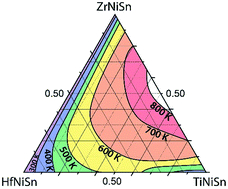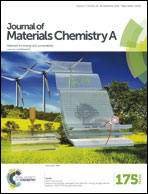Origins of phase separation in thermoelectric (Ti, Zr, Hf)NiSn half-Heusler alloys from first principles†
Abstract
A high thermoelectric performance has been achieved in half-Heusler alloys of composition MNiSn (M = Ti, Zr, Hf). The enhanced properties are attributed to the formation of microscale Ti-rich and Ti-poor grains. The mechanism of phase separation remains unclear, as the composition and microstructure of the grains are highly dependent upon synthesis conditions. This work uses first principles density functional theory, combined with the cluster expansion method, to calculate a thermodynamic phase diagram of the full pseudo-ternary (Hf1−x−yZrxTiy)NiSn system. The results show that ZrNiSn and HfNiSn are fully miscible at all temperatures, and that a miscibility gap between (Zr, Hf)NiSn and TiNiSn exists at temperatures below 850 K. For temperatures above 850 K, a solid solution is found to minimize the free energy. The low critical temperature of 850 K challenges the prevailing interpretation that the microstructure is created by an intrinsic phase separation mechanism, such as spinodal decomposition. Calculated migration barriers for Ti, Zr, and Hf atoms show that Ti-rich and Ti-poor grains may be non-equilibrium states that are kinetically trapped after solidification.


 Please wait while we load your content...
Please wait while we load your content...